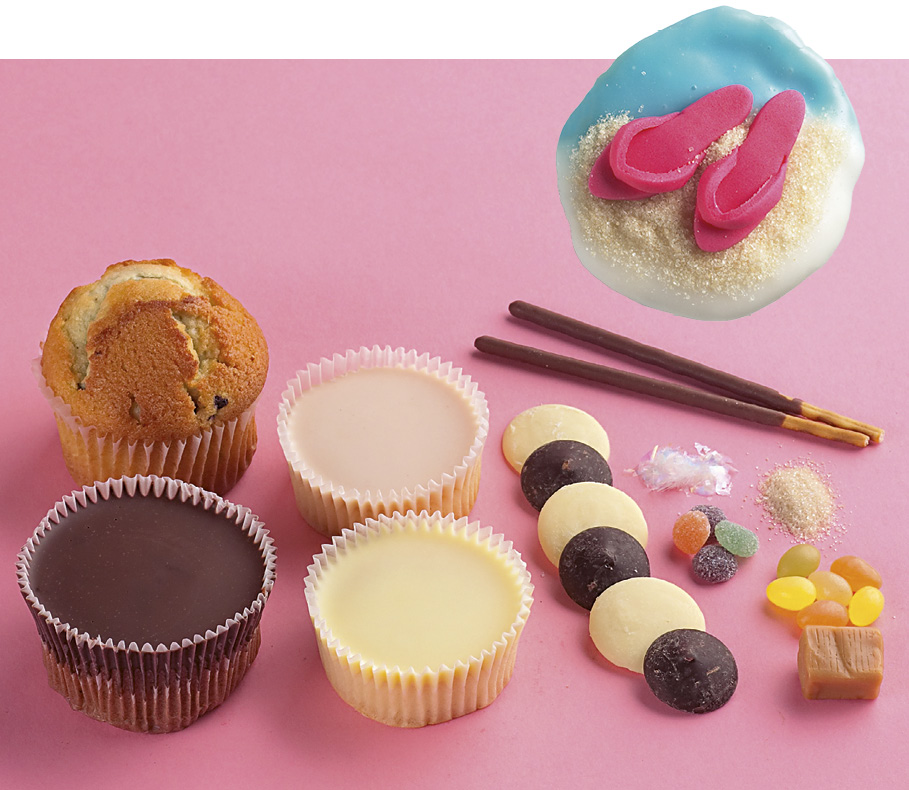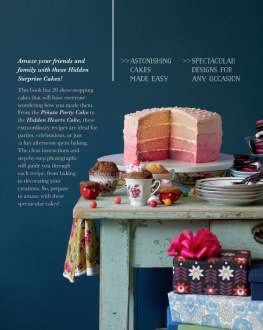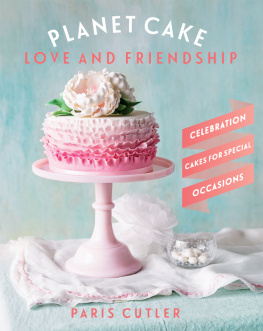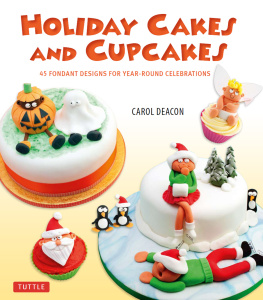

Frances McNaughton has been a tutor and demonstrator since 1987 and became a demonstrator for the British Sugarcraft Guild in 1995. She teaches all aspects of sugarcraft from beginners to advanced and to other sugarcraft tutors. She teaches from a studio in her own home but also travels all over the UK providing demonstrations and workshops for other Guild members and sugarcraft clubs. Frances made sugarcraft props for the films Notting Hill, Chocolat , three of the Harry Potter films and Charlie and the Chocolate Factory . She has also demonstrated sugarcraft several times on television.

First published in Great Britain 2009 Search Press Limited
Wellwood, North Farm Road,
Tunbridge Wells, Kent TN2 3DR Text copyright Frances McNaughton 2009 Photographs by Roddy Paine Photographic Studios Photographs and design copyright Search Press Ltd 2009 All rights reserved.
No part of this book, text, photographs or illustrations may be reproduced or transmitted in any form or by any means by print, photoprint, microfilm, microfiche, photocopier, internet or in any way known or as yet unknown, or stored in a retrieval system, without written permission obtained beforehand from Search Press. Print ISBN: 978-1-84448-519-2 EPUB ISBN: 978-1-78126-022-7 Kindle ISBN: 978-1-78126-077-7 PDF ISBN: 978-1-78126-131-6 The Publishers and author can accept no responsibility for any consequences arising from the information, advice or instructions given in this publication. Readers are permitted to reproduce any of the items in this book for their personal use, or for the purposes of selling for charity, free of charge and without the prior permission of the Publishers. Any use of the items for commercial purposes is not permitted without the prior permission of the Publishers. Suppliers If you have difficulty in obtaining any of the materials and equipment mentioned in this book, then please visit the Search Press website for details of suppliers:
www.searchpress.com
| This book is dedicated to my sisters, Annie, Rosie and Emma, and to my brother, John. |


Contents
Introduction Small is the new big! Cup cakes are a very popular way of celebrating any special occasion.
They can be a colourful and tasty display for any party table. Some modern weddings even choose cup cakes as the centrepiece. Even if you dont have a special occasion, why not just make cakes for family and friends its a great way of practising recipes and icing ideas to use on larger cakes. There are many different cake recipes which can be used to make delicious cup cakes in fact most cake recipes for large cakes are also suitable for making small cakes. More and more people are discovering the delights of cake decorating by having a go at making cup cakes. 
Making cup cakes

A large range of flat-iced cupcakes, plain fairy cakes and muffins are available in supermarkets and bakeries for those who just want to do the icing part! Small jelly sweets, melted chocolate, chocolate-covered stick biscuits, soft, golden sugar, edible glitter flakes and soft fudge have been used in this book to create simple designs.

Making cup cakes

A large range of flat-iced cupcakes, plain fairy cakes and muffins are available in supermarkets and bakeries for those who just want to do the icing part! Small jelly sweets, melted chocolate, chocolate-covered stick biscuits, soft, golden sugar, edible glitter flakes and soft fudge have been used in this book to create simple designs.
This all-in-one sponge cake recipe makes twelve small cupcakes: 115g (4oz) self-raising flour, sieved 115g (4oz) soft cake margarine or soft butter 115g (4oz) caster sugar 2 eggs Preheat the oven to 180C/350F/Gas mark 4. Line a cup cake tin with paper cases. Different tin sizes are available, and you can buy paper cases to go with each size. Put all the ingredients in a bowl. Beat with a wooden spoon for 23 minutes. If using a food mixer, reduce the beating time: only beat until the mixture becomes smooth and glossy.
Spoon the mixture into the cases about half full for flatter cakes, about three-quarters full for more domed cakes. Bake in the centre of the oven for 1520 minutes until golden and the tops spring back when pressed gently. Allow longer baking time for deeper and larger cakes. Alternative flavours Chocolate: add 15ml/1 tablespoon of cocoa powder mixed with 15ml/1 tablespoon of boiling water. Lemon: add10ml/2 teaspoons of lemon juice and 5 ml/1 teaspoon of grated lemon rind. Coffee: add 10ml/2 teaspoons of instant coffee dissolved in 5ml/1 teaspoon of hot water.
You can make different sizes from small sweet cases through to large muffin cases. Depending on the design you want to make, the cake can be baked so that it only fills up to the top of the case when baked, for a flat design; or it can be baked with more cake in the case, to form a dome when it is baked. If the cake rises more than you want, or is cracked on the surface, simply carve off the top to make it domed or flat. Basic tools Piping bags with piping tubes/nozzles Small cutters in shapes such as primrose, small rose petal, holly leaf and heart Round biscuit cutters (plain and frilly) Quilt embosser Cutting wheel Flower centre tool Small palette knife Small rolling pin Small, sharp scissors 
Over the Rainbow Materials: Cup cakes in brightly coloured cases White frosting: 170g (6oz) white vegetable fat (shortening) 450g (16oz) icing sugar 34 tablespoons (4560ml) milk or lemon juice Vanilla essence Food colourings: blue, red, yellow and green Tools: Small palette knife At least four greaseproof paper piping bags No. 3 or 4 plain piping tube (or snip the end off a paper piping bag)

Instructions: Make the white frosting by mixing the fat, sugar and flavouring, then beat in a few drops of water or milk to form a smooth, soft icing for piping. Using white vegetable fat keeps the icing white for the clouds, and blue for the sky.
If you prefer to use butter for a better flavour, the clouds will look creamy and the blue will not be so bright. Mix a portion of the frosting with red food colouring, another with yellow and another with green. Fill the piping bags (with or without the piping tubes) with a large spoonful each of frosting: white, red, yellow and green. Mix blue colouring into the rest of the frosting and spread over the surface of each cake with a palette knife. Pipe a curved red line half way round each cake, then repeat with the yellow, then the green. 















 Frances McNaughton has been a tutor and demonstrator since 1987 and became a demonstrator for the British Sugarcraft Guild in 1995. She teaches all aspects of sugarcraft from beginners to advanced and to other sugarcraft tutors. She teaches from a studio in her own home but also travels all over the UK providing demonstrations and workshops for other Guild members and sugarcraft clubs. Frances made sugarcraft props for the films Notting Hill, Chocolat , three of the Harry Potter films and Charlie and the Chocolate Factory . She has also demonstrated sugarcraft several times on television.
Frances McNaughton has been a tutor and demonstrator since 1987 and became a demonstrator for the British Sugarcraft Guild in 1995. She teaches all aspects of sugarcraft from beginners to advanced and to other sugarcraft tutors. She teaches from a studio in her own home but also travels all over the UK providing demonstrations and workshops for other Guild members and sugarcraft clubs. Frances made sugarcraft props for the films Notting Hill, Chocolat , three of the Harry Potter films and Charlie and the Chocolate Factory . She has also demonstrated sugarcraft several times on television.  First published in Great Britain 2009 Search Press Limited
First published in Great Britain 2009 Search Press Limited
 Contents
Contents
 A large range of flat-iced cupcakes, plain fairy cakes and muffins are available in supermarkets and bakeries for those who just want to do the icing part! Small jelly sweets, melted chocolate, chocolate-covered stick biscuits, soft, golden sugar, edible glitter flakes and soft fudge have been used in this book to create simple designs.
A large range of flat-iced cupcakes, plain fairy cakes and muffins are available in supermarkets and bakeries for those who just want to do the icing part! Small jelly sweets, melted chocolate, chocolate-covered stick biscuits, soft, golden sugar, edible glitter flakes and soft fudge have been used in this book to create simple designs. 
 Instructions: Make the white frosting by mixing the fat, sugar and flavouring, then beat in a few drops of water or milk to form a smooth, soft icing for piping. Using white vegetable fat keeps the icing white for the clouds, and blue for the sky.
Instructions: Make the white frosting by mixing the fat, sugar and flavouring, then beat in a few drops of water or milk to form a smooth, soft icing for piping. Using white vegetable fat keeps the icing white for the clouds, and blue for the sky. 